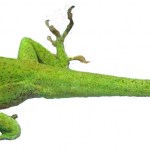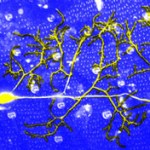Regeneration
Photo of zebrafish housed at a research institute. By Karol Głąb CC BY-SA 3.0. via Wikimedia Commons
Who would have thought tiny fish could lead to big advances in medicine? Zebrafish (Danio rerio) and mammals have similar anatomy and physiology of the brain, eyes, gut, and cardiovascular systems. Some of the reasons why these fish are good models to understand cardiovascular physiology were recently explored in a new article published in Physiological Reviews.
Animal models are used in research that seeks to understand both normal physiological mechanisms as well as mechanisms…
I came across a neat article in Scientific American that described how reindeer and elk regrow their antlers every year. Could you imagine putting that much energy into growing new bone each year complete with a velvety cover containing nerves, skin, and blood vessels? Although full-grown antlers lose their blood supply and animals scrape the velvet layer off to reveal just bone.
Researchers have explored whether understanding this amazing process of annual antler regeneration could lead to new therapies to regrow nerves or organs in humans. The nerve fibers that…
Image of brittle star by Jerry Kirkhart from Los Osos, Calif. [CC BY 2.0 (http://creativecommons.org/licenses/by/2.0)], via Wikimedia Commons
A new study published in Frontiers in Zoology examined the developmental process involved in regulating limb regeneration in brittle stars (Amphiura filiformis) following amputation of an arm. Limb regeneration is a multi-stage process involving initial healing and repair of the wounded site, initial growth of the limb followed by development of more complex layers of cells until ultimately the limb has been fully regenerated. …
A reader sent me the following question:
"How does a lizard grow a new tail?"
This was a very timely question as new research has shed light on this very phenomenon. A team of experts at Arizona State University led by Dr. Kenro Kusumi and colleagues have been studying limb regeneration in lizards.
Green anole lizard (Anolis carolinensis) with tail a new tail (image credit: Hutchins et al./PLoS ONE)
The green anole lizard (pictured above) can lose its tail when captured by a predator. They are then able to regrow their tails, although they do not look quite like the original. Dr.…
Solar cells made with bismuth vanadate achieve a surface area of 32 square meters per gram. This compound can be paired with cheap oxides to split water molecules (and make hydrogen) with record efficiency.
Short-term geoengineering could postpone global warming, only to have it happen more quickly in the future.
Carotenoids tinge blackbird bills a deep orange, signalling fitness; birds with oranger bills are "are heavier and larger, have less blood parasites and pair with females in better condition than males with yellow bills."
Fibroblasts can extrude a tidy biological…
Artist's rendition of dendrite regeneration in a fruit fly during metamorphosis. (Chay Kuo Lab, Duke University)
Researchers at Duke University are interested in understanding the metamorphosis of fruit flies from larvae to adult stage in an effort to understand how the insects grow new nerve endings as they undergo this transition. What is interesting is that the flies lose neurons they will not need as an adult and will grow new nerve endings. According to a press release from Duke University, a protein called Cysteine proteinase-1 (Cp1) is important in the regeneration step. In fact,…
You might be familiar with tissue regeneration in amphibians and reptiles where limbs can be fully regenerated following an injury. Until now, tissue regeneration following a wound was thought to be limited in mammals (ex: deer shed and regrow their antlers annually; some mice can regrow the tips of their fingers).
Researchers discovered that African spiny mice are able to regrow skin, complete with hair follicles, after an injury. We are not talking about simple wound healing, but actual skin regeneration without scarring. Researchers suspect this unique ability may have evolved to help them…
On a recent visit to The American Physiological Society's website, I found this amazing story on regeneration that I thought you might enjoy:
This summer’s action film, “The Amazing Spider-Man™,” is another match-up between the superhero and his nemesis the Lizard. Moviegoers and comic book fans alike will recall that the villain, AKA Dr. Curt Connors, was a surgeon who, after losing an arm, experimented with cell generation and reptilian DNA and was eventually able to grow back his missing limb. The latest issue of the journal Physiology contains a review article that looks at…
tags: Growing Organs, medicine, TEDMED,regeneration, stem cells, organ, tissue, Anthony Atala, TEDTalks, streaming video
Anthony Atala's state-of-the-art lab grows human organs -- from muscles to blood vessels to bladders, and more. At TEDMED, he shows footage of his bio-engineers working with some of its sci-fi gizmos, including an oven-like bioreactor (preheat to 98.6 F) and a machine that "prints" human tissue.
TEDTalks is a daily video podcast of the best talks and performances from the TED Conference, where the world's leading thinkers and doers give the talk of their lives in 18…
It is literally very difficult to mend a broken heart. Despite its importance, the heart is notoriously bad at regenerating itself after injury. If it is damaged - say, by a heart attack - it replaces the lost muscle with scar tissue rather than fresh cells. That weakens it and increases the chance of heart failure later on in life. No wonder that heart disease is the western world's leading cause of death and illness.
If that picture seems bleak, two teams of scientists have some heartening news for you. The first has found that the heart does actually have the ability to renew its cells,…
This is rather clever. Houle et al at Case Western show in the Journal of Neuroscience that you can use a bacterial enzyme called chondroitinase to degrade scars in spinal cord lesions and enable regeneration of axons.
Just for background, there is some interesting neurobiology when it comes to spinal cord regeneration. If you sever peripheral nerve axons and then reconnect it, the axons will regrow to find their old targets leading to a functional restoration. However, something different happens in the central nervous system (CNS). Instead of regrowing, the axons just stop.
For many…




